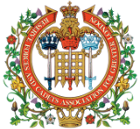Reorganisation of London Units 1967-1968
- In 1967 the Territorial Army was replaced by the Territorial and Army Volunteer Reserve. In this, some units were to have the function of providing immediate reinforcements for the Regular Army in an emergency, and had a rather more arduous training commitment than in the old Territorial Army. These resuscitated the old title of 'Volunteer' units. The other units were relegated to a Home and Civil Defence role, and were designated 'Territorial' units. In Army Order 2 dated 28th January 1967 and in the Army Reserves Succession Warrant 1967, the new Territorial and Army Volunteer Reserve units were raised with effect 1st April 1967 and the existing Territorial Army units were deemed to have been disbanded. This technically meant that there was no succession to descendant units. However, the warrant also stated that ‘the wish to provide for succession of units raised' and then listed those new units which would be regarded as successors to previous Territorial Army Units. All the descendant component parts of the London Regiment (1993) were included in this list.
- In this reorganisation, the fourteen successor Territorial Army units were re-deployed as follows.
- In the Royal Artillery, the 265th Light Anti-Aircraft Regiment (4, 7, 8, 20, 21, 24) together with part of The Kent and County of London Yeomanry became The London and Kent Regiment (Territorials); and the 300th (11, 17, 19) and the 254th (14) became The Greater London Regiment (Territorials).
- In the Royal Corps of Signals, the 41st (13) and the 47th (25) were reduced to squadron strength and
- were amalgamated within the 31st (Greater London) Signal Regiment (Volunteers) in 1967. 31st Signal Regiment had a third squadron, numbered 83rd .
- In the infantry there had been much amalgamation of regular Regiments, and the old titles had disappeared. The Queen's Surreys and The Middlesex Regiment amalgamated with The Queen's Own Buffs and The Royal Sussex to form The Queen's Regiment. 3rd and 4th Queen's Surreys (6, 22, 23) became 6th (Territorial) Battalion, The Queen's Regiment; and 5th Middlesex (3) became 10th (Territorial) Battalion. In addition, these units provided the nucleus of A and D Companies of the 5th (Volunteer) Battalion.
- In the Royal Fusiliers, the City of London Battalion, descending from the 1st and 2nd City of London Regiments (Royal Fusiliers), became a Company of the Fusilier Volunteers in 1967. A year later after The Royal Fusiliers, The Royal Northumberland Fusiliers, The Royal Warwickshire Fusiliers and The Lancashire Fusiliers were all amalgamated to form The Royal Regiment of Fusiliers, this company was re-designated as part of the 5th (Volunteer) Battalion, The Royal Regiment of Fusiliers.
- The King's Royal Rifle Corps and The Rifle Brigade were amalgamated with The Oxfordshire and Buckinghamshire Light Infantry to form The Royal Green Jackets. The Queen's Royal Rifles (9, 15, 16) became B Company, and the London Rifle Brigade/Rangers became C Company of 4th (Volunteer) Battalion, The Royal Green Jackets. Together they also formed the 5th (Territorial) Battalion.
- Among the Scottish Regiments there was not the same degree of amalgamation, and there was thus no combined Regimental title available for Volunteer units. Consequently, two new Volunteer units were formed – 51st Highland Volunteers and 52nd Lowland Volunteers. (These titles perpetuated the titles of the 51st (Highland) and 52nd (Lowland) Divisions in the two World Wars.) The London Scottish (14) became C Company of the 51st Highland Volunteers. They also formed, with the Inns of Court and City Yeomanry, The London Yeomanry and Territorials.
- Meanwhile, in 1968, The Royal Ulster Rifles had amalgamated with The Royal Inniskilling Fusiliers and The Royal Irish Fusiliers to form The Royal Irish Rangers; and their Volunteer unit, The North Irish Militia, became a Battalion of the new Regiment, and The London Irish Rifles (18) became D Company of The North Irish Militia.
- Only the Artists Rifles (28) were unaffected, becoming a Volunteer unit without change of title.
- In 1968 the successors of The London Regiment stood as follows:
1908 London Regiment BattalionRoyal Regiment of Artillery:11, 14, 17, 19The Greater London Regiment (Territorials)4, 7, 8, 20, 21, 24The London and Kent Regiment (Territorials)Royal Corps of Signals:13, 2531st (Greater London) Signal Regiment (Volunteers)The Queen's Regiment:6, 22, 23A Company (Queen's Surreys), 5th (Volunteer) Battalion3D Company (Middlesex), 5th (Volunteer) Battalion6, 22, 236th (Territorial) Battalion (Queen's Surreys)310th (Territorial) Battalion (Middlesex)The Royal Regiment of Fusiliers:1, 2C (City of London) Company, 5th (Volunteer) BattalionThe Royal Green Jackets:9, 15, 16B Company (Queen's Royal Rifles), 4th (Volunteer) Battalion5, 12C Company (London Rifle Brigade Rangers), 4th (Volunteer) Battalion5, 9, 12, 15, 165th (Territorial) Battalion51st Highland Volunteers:14G Company (London Scottish)The London Yeomanry and Territorials:14C Company (The London Scottish) The North Irish Militia:18D Company (London Irish Rifles)2821st Special Air Service Regiment (Artists) (Volunteers)
